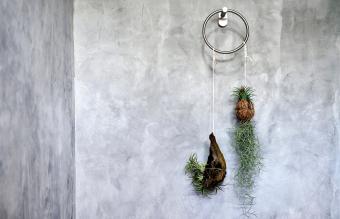
Plants can totally liven up an office space, but they also require care that people in busy offices may neglect. But the five best plants for your office are ideal for large or small spaces. You can liven up your work area without adding to your workload with these low-maintenance plants.
1. Pothos

The pothos plant (Epipremnum aureum) makes a great addition to a shelf or tall cabinet, so the trailing plant has ample growing space. You can opt for a jade pothos or golden pothos that offers texture and variegated green and yellow colors.
This plant is versatile and can tolerate windowless offices with artificial, indirect, and bright indirect light. It's very forgiving if you forget to water it since it doesn't like a lot of water. A once-a-week watering is sufficient. Pothos plants require light fertilizing, so you can feed them once a month. You may find a houseplant fertilizer spike with slow release over several months is more convenient.
Related: 12 Low-Maintenance Indoor Plants Anyone Can Care For
2. Succulents

Succulents come in many shapes and colors. This is a great low-maintenance plant. You can neglect it, and it won't know the difference.
A succulent needs to receive some indirect light during the day, and most can tolerate direct sunlight. You only need lightly water succulents once a week. A popular succulent is the jade plant. Unlike compact succulents, the jade plant grows in height, so it will need ample headroom to grow.
3. Air Plant

The air plant (Tillandsia) is an amazing choice for any office. This plant is ideal if you are often out of the office since it can be severely neglected and still thrive. You don't even need soil to grow this plant since it gets its nutrients from the air. You can stick this plant on a shelf, a rock, or any surface so its roots can cling to it for stability. An aerium (atrium) for an air plant may be a nice addition to your desk or file cabinet.
Air plants prefer indirect but bright light and need to be misted with water once a week. You'll need to soak your plant(s) once every 10-14 days.
- Soak plant(s) in room temperature water for 10 minutes.
- After soaking your plant, gently shake excess water free.
- Allow the plant to dry on top of a paper towel.
- Plant roots should dry within a couple of hours to avoid root rot.
- Return the plant to its normal resting place.
4. Creeping Fig

The evergreen creeping fig (Ficus pumila) is a low-maintenance plant that can be placed on a shelf or tall cabinet or in a hanging basket. This climbing plant features small heart-shaped leaves. The stems grow in a twisted wiry appearance. Traditionally, this plant is grown outside, like ivy, but it can easily be trained to grow inside. There is also a variegated species.
You will most likely need to prune the creeping fig every now and then to keep it under control since it is a climbing vine plant. You can always create new plants from the cuttings by first rooting them in water and then transplanting them. The plant requires indirect bright light but can survive in low light. Water enough to saturate the soil, but don't allow water to pool in a tray since it can cause root rot. Don't allow the soil to dry out. Fertilize once a month during the spring and summer growth period.
5. ZZ Plant

The ZZ plant (Zamioculcas Zamiifolia) is an easy-maintenance plant. The plant features fat stalks with glossy dark green leaves. This plant makes a great desk or cabinet plant. It is a slow-growing plant that can eventually grow up to three feet high.
The ZZ can survive the most neglectful plant owner. Its root system and oversized stalks store water and can release it as needed. While the plant prefers bright indirect light, it can survive low-light environments. You can fertilize the plant during the spring growing months, but the plant doesn't require much fertilizer.
Choosing the Best Plants for the Office
Even if you aren't a natural gardener, you can select the best plants for your office by choosing ones that don't require a lot of maintenance. Your coworkers will envy your new green thumb!







